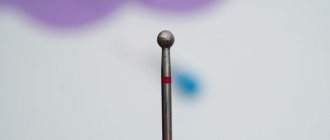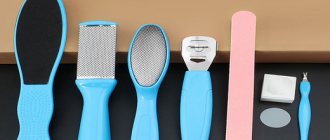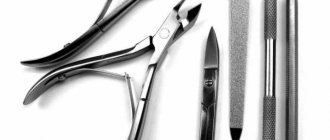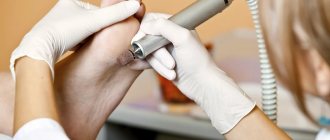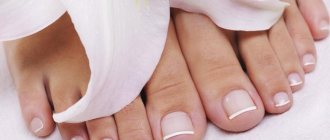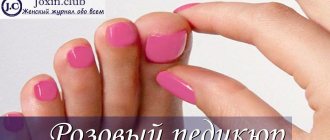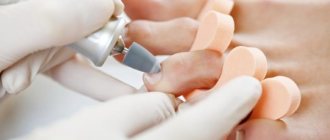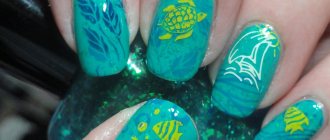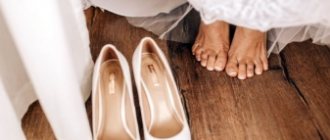Kinds
To maintain the natural beauty of women's feet, modern cosmetology offers different pedicure techniques, the types of which can be divided into traditional and exotic. The list of traditional ones includes:
- classical;
- European;
- hardware;
- combined.
Innovative and exotic include:
Of all the existing varieties of skin and toe care, everyone can choose the best option for themselves. Moreover, many procedures can be carried out not only in expensive salons and beauty studios, but also at home. Their main differences lie in the use of certain tools, a set of special care products or special equipment.
A short overview of existing types of pedicure
Beauty salons will offer you a choice of several nail and foot skin care procedures, which will differ in price, duration, method of treating feet and toenails, and results. How to understand and master their main differences so that you can taste exactly what you want? A brief overview of the most popular salon treatments will help you make the right choice.
Classic (edged) pedicure
Of all the types of pedicure, the classic one is the oldest, since it has been used to care for feet for more than a hundred years. It has absorbed the experience of many years of cosmetology, and it has its own characteristics:
— to begin with, with a classic pedicure, the skin of the feet is steamed in pleasant warm baths with the addition of table or sea salt and soap;
— all manipulations (removal of cuticles or dead skin from the feet) are carried out using cutting instruments.
It is the classic pedicure that is so easy to do at home, and if you are not a fan of beauty salons and hardware cosmetology, you will probably like it. But be extremely careful: with a classic pedicure, there is a high risk of cutting yourself with a sharp blade when cutting the cuticle.
Also in the section: How to get rid of hangnails
European (unedged, dry) pedicure
Many people call European pedicure a variety of classic, but now it is listed everywhere as a separate direction, because it has its own characteristics:
— the skin of the legs is not steamed before the procedure, everything is done “dry”, but you don’t have to be afraid: you won’t feel any pain or discomfort;
- the cuticle is removed gradually (it is the methods of removing the cuticle that are the main difference between the types of pedicure): a special product is applied to it, which slows down its growth and softens it;
- the cuticle is not cut, but carefully pushed to the edge of the nail;
— for keratinized skin, European pedicure offers soft but effective graters and scrapers.
Get ready for the fact that you won’t get away with one visit here: at least 8–10 procedures are required to gently and accurately remove the cuticle. You can also easily perform a European pedicure yourself: perhaps only these types of pedicure (classic and European) can be performed at home. All the rest are the calling card of beauty salons.
Also in the section: How to make your nails strong
Hardware pedicure
With the development of hardware cosmetology, this foot care technique also appeared, which has existed for more than 40 years. If the above methods are carried out manually, then cutters will delicately and gently take care of your legs. This is the name given to the replacement attachments of the pedicure apparatus, which perform various functions:
- remove the cuticle;
- give shape to nails;
- polish them;
- remove the stratum corneum from the foot.
In this case, special solutions and products are used to soften the skin. There is no need to be afraid of unforeseen side effects: trauma and the risk of infection are reduced to almost zero. But the results will exceed all your, even your wildest expectations! After all, the main difference between hardware pedicure and other types is that it eliminates excessive skin removal, as a result of which the coarsening of the feet occurs much more slowly. After this procedure, you will be able to enjoy the softness and tenderness of your heels for a long time.
SPA pedicure
If you are uncomfortable with the cutting objects of a classic pedicure, the too long course of a European pedicure and the whirring cutters of a hardware one, a SPA pedicure will certainly be a saving ray for you in the dark kingdom:
— you will be offered aromatic foot baths;
- get a foot massage;
- nourish and moisturize the skin with special masks.
All cosmetic products are designed specifically for the skin and nails of the feet, and they contain fairly highly effective and high-quality components. In addition to unearthly pleasure, you will receive an excellent result: well-groomed and beautiful legs.
Combined pedicure
Combined pedicure takes into account the individual characteristics of each client. A professional determines which type of pedicure can be used in this case to remove the cuticle, and which type to remove the stratum corneum.
Permanent pedicure
This method appeared relatively recently and is aimed primarily not at caring for the skin of the feet, but specifically at the condition of the nails. Here you can quickly and efficiently:
- remove the cuticle;
- will degrease the nail plate;
— complete disinfection of the nail;
— extensions with acrylic or gel in various ways (forms, tips);
- giving nails a beautiful, refined shape by filing, grinding and polishing.
It would be a good idea to get a permanent pedicure before going to the seaside.
Today every beauty salon provides all of the above methods to its clients. Knowing the features of each of them, you can determine for yourself their advantages and disadvantages.
Classic pedicure
The technology of classic pedicure has been used for several centuries. The entire foot and nail care procedure includes several stages:
- The feet are steamed in a bath of warm water. Special softening and disinfectants, sea salt, baking soda, essential oils, decoctions and infusions of medicinal plants are added to the water.
- Treat the soles and heels with pumice, a file or a grater. If necessary, the rough skin is cut off using a machine with a sharp blade.
- Cuticles and overgrown skin are removed with scissors and nippers.
- Give the nails the desired shape - trim and file the nail plates.
- Nails are degreased, a decorative coating is applied to them, and hands are lubricated with a moisturizing and nourishing cream.
The advantages of a classic pedicure include its accessibility and simplicity: purchasing a basic set does not require large financial expenditures, and every woman can master the classic pedicure technique if she wishes. Therefore, representatives of the fair sex often do trimmed pedicures on their own without visiting a beauty salon.
However, this technology also has a number of disadvantages:
Excessive cutting of the keratinized skin of the feet causes discomfort and pain, and also triggers regeneration processes and causes increased growth of epidermal cells. The skin on the heels and soles of the feet constantly becomes coarser and thickens, forcing the woman to turn to specialists again.
Classical
Among the wide variety of foot care methods, classic pedicure is the most common and simplest method of treating the cuticle and nail plate. Classic pedicure is suitable for both women and men of all ages. The only difference is in covering the nails with colored varnishes and different decor for the weaker half.
Pedicure technique:
- Softening foot bath for 15 - 20 minutes. A classic pedicure begins with a foot bath. You can add sea salt or a special concentrate for pedicure to it; deodorizing, antiseptic substances, oils, plant extracts, various moisturizing and nutritional additives are also added to the bath to clean and soften the skin of the foot and cuticles for subsequent treatment.
- Elimination of calluses and corns. After a softening bath, the pedicurist treats the skin of the feet with a special antiseptic and removes keratinization and corns from each foot in turn. Depending on the degree of coarsening of the skin, disposable blades or special files (graters) are used. It is possible to use peeling (scrub) for the skin of the feet. At home, it is best to use fine-grained pumice or a soft brush. The problem of calluses and corns is discussed in more detail in the article “Foot Care”.
- Cuticle removal. 3-5 minutes before removing the cuticle, a softener is applied to it. The cuticle is removed by trimming or untrimming. In the latter case, the cuticle is carefully pushed back with a special stick.
- Correction of the shape of the nail plate. The nail is given the desired shape using nail clippers and nail files. If necessary, the nail plate is polished to remove unevenness and roughness and add shine. An important question that arises when performing a pedicure: how long should you shorten your nails? Long nails rest against closed shoes and damage themselves, as well as tearing stockings. And nails cut too short, “at the root,” can grow into the fingers and cause inflammation. In the summer, in sandals with open toes, you can allow yourself to have long nails, but without disturbing the comfortable condition of the foot.
- Softening and moisturizing the skin of the feet. Cream is applied to the feet: it can be nourishing if the skin on the feet is dry. For excessive sweating, a deodorant cream is suitable. And if your problem is fatigue and heaviness in your legs, use a special product with a tonic effect. At the end of the procedure, you can apply a special strengthening oil to your nails.
- Foot massage. After this, a light foot massage is performed for better absorption of the cream.
- Covering nails with medicinal or colored varnish. At the end of the procedure, a base varnish is applied to the nails, which prevents possible yellowing of the nail, smoothes the surface, and strengthens the nail plate. After 1 minute, 2-3 layers of the main colored varnish are applied, and then, after it dries, a fixative is applied, which extends the service life of the pedicure.
The duration of a classic pedicure can vary from 30 to 60 minutes depending on the number of stages, because With constant care, you can neglect some procedures and limit yourself to only polishing, coating, or pampering yourself with a relaxing aromatic bath and massage.
European
To carry it out, you do not need to use cutting tools and steaming baths, so the innovative technique is often called dry or uncut.
European pedicure takes a lot of time, because... To achieve the final result, it will take from 5 to 10 procedures. Using this gentle technique, it is impossible to tidy up neglected feet and toes, so it is more suitable for children, women and men with thin skin and well-groomed feet.
The main feature of dry pedicure is the use of special compounds - removers, which allow you to soften the cuticle, dissolve and remove it. If at first you carry out foot care according to the European method every 2 weeks, then later, when the cuticle becomes thinner, you can visit the salon no more than once a month.
Technology for unedged pedicure:
- The nail bed is treated with remover.
- After 5-15 minutes, the cuticle is removed with an orange stick, and the skin around the nail plates is sanded with a file.
- Model the shape and length of nails.
- The softening composition is applied to the skin of the feet, left for 15-20 minutes, then the roughened epidermis is removed with a pumice stone or a brush.
- Apply nourishing and moisturizing cream.
- They give a foot massage, which increases blood circulation and improves nutrition of skin cells and nail plates.
- At the client's request, a strengthening, healing or decorative varnish coating is applied to the nails.
European pedicure has many advantages. Its painless and safe technique eliminates the possibility of infection, the development of an inflammatory process or fungal infections of the skin and nails. With each subsequent session, the cuticle will become thinner, so with regular home foot care, an unedged manicure can be done no more than once every 4-5 weeks. The price for the services of a salon master with dry pedicure skills is low, and the procedure itself is a unique way of relaxation and relaxation.
Japanese pedicure
This is a delicate treatment procedure aimed at improving foot health. This type of pedicure is performed in an untrimmed manner using natural products and materials that help treat and eliminate various problems with nails and skin: calluses, corns, cracks, and also improve the general condition of the skin and nail plates. The peculiarity of this type of pedicure is that only natural preparations and materials are used to perform it.
When doing a pedicure in a beauty salon, be sure to ask the master how he processes the tools. According to the standard, a special sterilizer device must be used, in which a high temperature is created. Hepatitis viruses, HIV, fungal and other infections die only after such treatment.
Elena Kobozeva, dermatovenerologist, cosmetologist: “Pedicure is an excellent foot care procedure. During the process, dead skin is removed and the legs acquire a neat appearance. You can do it both in the salon and at home. A classic pedicure is a rather traumatic procedure due to the likelihood of small cuts. Therefore, for example, it is advisable for people with diabetes to warn the specialist about their disease and ask them to be as careful as possible. Indeed, with this disease, all wounds and abrasions take much longer to heal than in healthy people, and can lead to various complications.”
Expert: Elena Kobozeva, dermatovenerologist, cosmetologist Author: Katerina Kapustina
The material uses photographs belonging to shutterstock.com
Hardware
This type of pedicure has long been included in the list of traditional salon services. It is carried out using a special device - a milling machine, which removes dead tissue and gently polishes the skin and nails. For high-quality care of toes and feet, cone-shaped and disk nozzles of different grain sizes are used, rotating at speeds from 6 to 40 thousand revolutions per minute. Consumables made from metal alloys or natural abrasives are selected individually, taking into account the shape of the nails and the structure of the client’s foot.
To remove the keratinized layer of skin, a specialist first applies a special solution or gel to the feet - a keratolytic, which softens the rough tissue.
Those with well-groomed feet can do without pre-treatment of the feet, because... You can also polish your heels using the device on dry skin.
Hardware pedicure helps to qualitatively treat the skin in the most inaccessible places, get rid of ingrown nails, calluses and corns, and prevent their reappearance. The procedure completely eliminates the risk of injury or infection of the skin.
Pedicure: types and features
Pedicure: types and features
Pedicure is an integral procedure for caring for the feet and toenails. What types of pedicure exist and how do they differ from each other?
pedicure, foot care
To make your feet feel comfortable and look attractive, you need to take care of them regularly. Pedicure is one of those procedures that will help maintain the health and beauty of your feet for many years.
It includes several main stages: cleansing, treating skin and nails, moisturizing and applying varnish. There are two main types of pedicure: classic (manual) and hardware. In addition, new variations of this procedure appear every year: combined pedicure, SPA pedicure, Japanese and even “fish” pedicure.
Hardware pedicure is considered safer and more gentle than classic pedicure, and is suitable even for sensitive skin. It helps get rid of many nail problems: ingrown nails, calluses, corns, changes in the nail plate, etc., and also prevents their reappearance.
Spa pedicure
To carry out this procedure, pedicurists use all kinds of scrubs, peelings, lotions, masks and other cosmetics containing a complex of useful components:
Spa pedicure takes place in several stages:
- Steam your feet in a bath or using socks with a special lotion.
- Peeling is done with natural-based scrubs.
- Massage your feet.
- Apply products that nourish, moisturize, rejuvenate and heal the skin of the feet.
Spa pedicure gives your feet a well-groomed and healthy look, allows you to relax, relieve fatigue and enjoy peace. Many spas and beauty studios offer it, but the cost of 1 session is high compared to other types of pedicure. This method of foot care is not suitable for people with problem skin, fungal infections of the skin and nail plates, or ingrown nails.
SPA pedicure
One of the most expensive methods is considered to be a spa pedicure, which involves not only tidying up the feet and nail plates, but also special care, during which cosmetics with natural ingredients are used. It contains plant extracts, various essential oils, algae, medicinal mud, salts and other nutrients.
First, the procedures process and shape the nails, after which they make a foot bath with the addition of oils. The next stages include peeling with a natural scrub, massage, and nourishing masks. Feet are processed both manually and using the hardware method.
After this, they proceed to the nail plates: apply a mineral paste to them, which seals the surface of the nail well, after which the product is rubbed into the plate with a suede nail file. At the next stage of the procedure, a base coat containing vitamins is applied to the nails. Next, a varnish coating is applied, and at the final stage - cuticle oil, which is carefully distributed around the nail.
Acid pedicure
For acid pedicure, special solutions, gels and creams based on fruit acids, urea, panthenol and other natural ingredients are used. These harmless compositions dissolve dead skin fragments, get rid of old corns, calluses and cracks, restore damaged nail plates and accelerate cell renewal.
Products for acid pedicure do not threaten health and do not cause allergies, so they can be applied to the skin of children, adolescents, pregnant and lactating women, clients suffering from diabetes, cardiovascular pathologies and other chronic diseases.
Stages of an acid pedicure:
- Feet are treated with a disinfectant.
- Apply a keratolytic with fruit acid to the rough areas of the skin, wrap the feet with film and leave for 15-20 minutes.
- They wipe their feet with a cotton napkin and remove keratinization from the feet with a sanding file or spatula.
- Apply nourishing or moisturizing cream.
An acid pedicure cannot be done if there are unhealed wounds, abrasions, cracks or wet calluses on the surface of the skin, because acid can penetrate deep into damaged tissues and worsen the situation.
Male
Men's pedicure today is not only about reducing calluses, but also about preventing the occurrence of fungal diseases and nail deformation. In addition, modern pedicure has become a rather pleasant, comfortable and painless procedure. Due to painlessness and effectiveness, hardware and spa pedicures are disproportionately popular among men.
Folk remedies for foot skin care (getting rid of cracks, calluses, corns) are described in detail in the article “Foot Care”.
loading…
Combined
The combined technique combines the advantages of classic and hardware pedicure: the master treats the client’s heels and soles with a milling machine, and tidies up the nails and cuticles manually using traditional tools and cosmetics.
In many beauty salons, specialists supplement the standard scheme with elements of other techniques. For example, to soften rough skin, instead of a bath, they use preparations with fruit and lactic acids, used in acid pedicures.
Therapeutic pedicure
Therapeutic pedicure involves solving all of the above foot problems - eliminating ingrown toenails and calluses, treating cracked heels and viral warts.
Podiatry centers have places equipped with appropriate equipment to help in the diagnosis and treatment of the above diseases. Here you can count on professional help and quick results. Even treating keratinized skin with deep, often bloody cracks, or eliminating an ingrown nail will not be a problem (which we can encounter in a regular beauty salon).
In case of problematic situations, for example, in the presence of a purulent inflammatory condition or progressive skin lesions, there is always help here too. At the center, they will take material from you for laboratory tests to diagnose their cause, and then develop a program for further treatment.
Fish
This exotic pedicure technique was originally used in some Asian countries, but over time it became widespread in Russia. The technique is quite simple:
- The client's feet are disinfected. Then he lowers them into a small pool (aquarium) with warm water (+32...+35°C), where several dozen garra rufa fish swim. These representatives of the Karpov family do not exceed 8-12 cm in length and feed on dead particles of the epidermis.
- The session lasts 20-30 minutes depending on the initial condition of the client's skin. During this time, the nimble fish manage to carry out a kind of peeling of the feet - to clean them of keratinized fragments and unwanted deposits (calluses, corns).
After the procedure, the skin on the legs becomes soft and tender. It does not require special tools, apparatus or cosmetics. It is enough to have a small school of fish, whose saliva has disinfectant, antifungal and healing properties. Therefore, any microtraumas, wounds and abrasions on the legs heal faster after the session.
The fish pedicure procedure is also called fish-spa, fish therapy or ichthyomassage: the movements of the fish feel like a light, pleasant massage, as a result of which local blood circulation increases, metabolic processes improve, and the skin becomes smooth and elastic.
This method of foot care has its drawbacks. Fish pedicure can only be done in large cities of Russia or during a trip to Asia. There is a possibility of infection transfer from one client to another, because... The water in the aquarium is not disinfected. For this reason, peeling with fish is prohibited in some countries of the world.
Methods and approaches
Depending on the level of the salon that provides foot care services, the client is offered one or another set of treatments. In addition to basic procedures, they can offer a relaxing massage. It is even possible to receive therapeutic or psychotherapeutic treatments during a pedicure session.
Existing types of pedicure (photo below) may include a course of paraffin therapy, depilation, and in-depth antiseptics. Such a wide range of procedures makes the presented service popular.
There are beauty salons that use all senses during the procedure. Aromatic oils, play of light, and sounds are used. During the procedure, a person listens to the sound of the surf, birdsong, etc. This is a very useful, relaxing effect. Color therapy also has a healing effect on the psyche. This allows you to escape from business and the daily hustle and bustle. During the session, a person relaxes both physically and psychologically.
